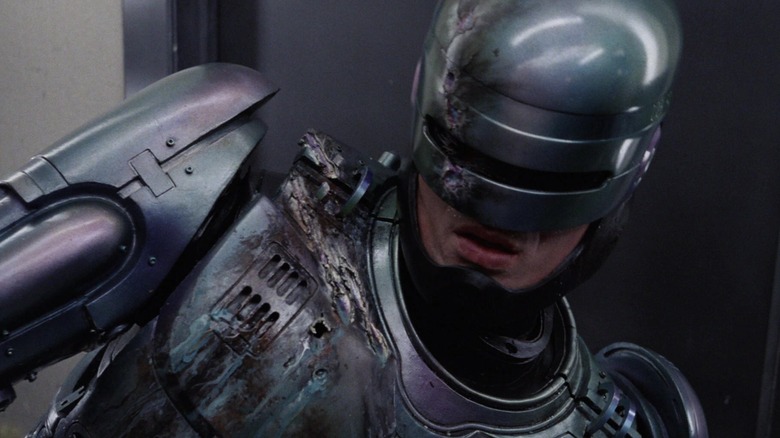How Paul Verhoeven's Manga Inspirations Nearly Ruined RoboCop's Iconic Design
Paul Verhoeven's dystopian Reagan-era sci-fi actioner "RoboCop" is set in a near-future Detroit when the police have been privatized. Naturally, no one benefits from this other than OCP, the wealthy corporation that owns the police. Its executives have been trying to find a way to automate police work, leading to the invention of a cannon-mounted, walking ultra-robot — the ED-209 — that, if it functions as intended, will stomp around the city's streets murdering criminals. As with all things corporate, though, it doesn't work. And because this is Detroit, the ED-209 looks a little bit like the front half of a sedan.
When the ED-209 fails, OCP steals the corpse of a recently slain cop named Murphy (Peter Weller) and uses his brain and parts of his body as the basis for RoboCop, a powerful, nigh-indestructible cyborg with a programmable conscience. OCP's cyborg suit has the same round shapes and shimmering paint job as a car. (Detroit's motor-city reputation stands, even when it's designing walking tank-bots and human-brain-powered cyborgs.) The design is perfect; an impeccable amalgam of sci-fi and a family vehicle.
And yet, Verhoeven once notoriously delayed the production of "RoboCop" because he felt that the design could be improved. It seems that Rob Bottin had already constructed a suit and that Weller was learning how to walk in it when Verhoeven got a wild hair about making the design "more dynamic." According to Esquire's 2014 oral history of the film, Verhoeven had been reading a lot of manga at the time, and he was taken with the Japanese art style. No one knows what titles he was reading, but he evidently liked the robot designs in his favorite comic books. Thus, he began asking Bottin to redesign the suit (after it was already designed) to look sleeker.
Paul Verhoeven's designs caused production delays on RoboCop
Bottin was eventually allowed to go with his original design, but Verhoeven's nitpicking and design criticisms slowed everything down. Luckily, Verhoeven was insightful enough to take blame for the production delays, saying:
"One of the most difficult things about making this film was the RoboCop suit. Ed Neumeier and I approached designer Rob Bottin to make the suit for us, and we had unrealistic expectations after reading too many Japanese comic books. So, we initially thought that Bottin's approach was not sensational enough, and we started to criticize his design, which was already done. And because Bottin, who is an extremely talented and sensitive artist, was given such false advice, the making of the suit was very difficult."
Ed Neumeier was, of course, one of the credited screenwriters on "RoboCop." He also wrote Verhoeven's satirical 1997 sci-fi action film "Starship Troopers." Verhoeven was a big enough man to acknowledge that Bottin was right all along. His ego was bruised, but he came around, stating:
"All my ideas were absolutely wrong, and it took us weeks and weeks to accept that. We were essentially sabotaging the suit, so when we started shooting, the suit wasn't ready. I'll take full responsibility for Bottin being late with the suit."
The biggest problem with the delay on the RoboCop costume is that Weller didn't quite have the time he needed to learn to walk in it. He improvised by learning how to walk in football equipment, but that wasn't comparable. The RoboCop suit was bulky and ungainly, and Weller had a lot of trouble adapting to it. This led to a big fight between the actor and the director, which threatened to upend "RoboCop" altogether.
Peter Weller was briefly fired from RoboCop over the suit
Verhoeven explained that Weller had been working with a mime named Moni Yakim to learn how to move more like an android. Of course, when the suit finally arrived, Weller found all kinds of unpleasant surprises. For one, he couldn't sit down while in the suit. All the shots of RoboCop sitting were filmed with Weller only wear the top half of the costume. Weller tried on the costume at a 4 a.m. costume fitting and went straight into a 12-hour shooting day. The scene Verhoeven was filming was the first time RoboCop entered the Detroit police precinct. Verhoeven remembered that day well, specifically how poorly everything went. In his own words:
"[Weller] was extremely frustrated because everything he thought he could do, he couldn't do. Peter then tried to get a grip on the situation by improvising, but that improvisation didn't fit the script at all. He and I would later shake hands after all the animosity that came about because of the problems. So, while the movie wasn't easy, I mostly remember it as a pleasant time. It was hard work, and long hours with an extremely good crew, and pleasant actors to work with, unlike 'Flesh+Blood,' which was extremely difficult from beginning to end."
"Flesh+Blood" was Verhoeven's first U.S. film, released just before the production of "RoboCop" in 1985. All the stories to come from the set of "Flesh+Blood" are horrid, so a row with his lead actor on "RoboCop" was comparatively a walk in the park. And it seems that Verhoeven and Weller put the bad blood behind them. Verhoeven would go on to make "Total Recall" with Arnold Schwarzenegger soon after, while Weller immediately made thrillers like "Shakedown" and "Leviathan." All was well.


